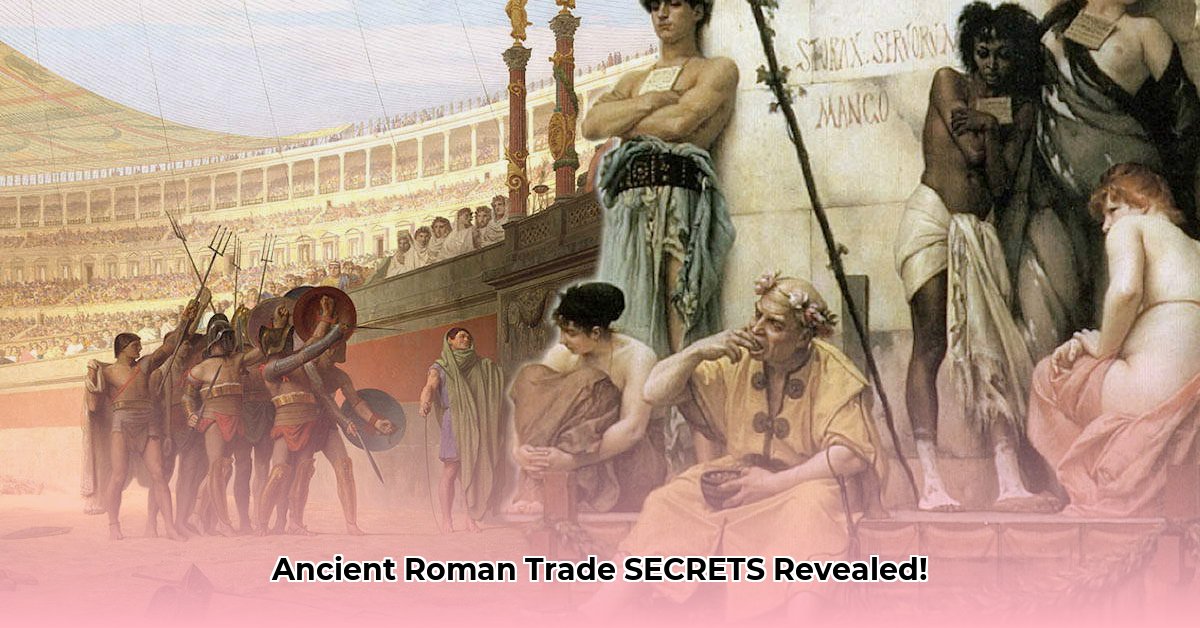Ever considered how the Roman Empire, renowned for its military prowess and monumental architecture, primarily funded its vast reach and sustained its immense population? It wasn’t solely through conquest. A sophisticated and far-reaching system of ancient Roman commerce served as the empire’s economic lifeblood, skillfully managing the perennial puzzle of resource distribution. This intricate network, characterized by a diverse range of goods, numerous distributed production centers, and extensive distribution channels, exemplifies what we might today call a “longtail” economic system. Similar to trade in ancient Greece. In this deep dive into history’s playbook, we will explore the ingenious mechanics of Roman trade, revealing how these ancient traders established an enduring economic network with surprising echoes in our modern world.
Ancient Roman Commerce: The Lifeblood of Empire
The Roman world thrived on an incredibly complex economic network. Imagine it as a vast, interconnected web, with threads of ancient commerce stretching across continents and seas from Britannia to the Persian Gulf. This sophisticated system, driven by ancient Roman traders, wasn’t merely about moving goods; it was fundamental to resource availability, cultural exchange, and the empire’s sustained prosperity. The Roman government played a crucial role, often setting the stage for private enterprises to flourish, directly influencing the empire’s success and, eventually, contributing to its transformation.
The Unseen Hand: Government and Private Enterprise
The Roman state was not a passive observer of its economy; it actively managed and encouraged trade infrastructure. For instance, the annona system, a state-controlled grain supply, was critical for feeding Rome’s massive urban population, which reached over one million, and its formidable army, which consumed some 70% of the state budget. This system aimed to ensure stability, preventing widespread hunger or unrest. Taxes levied on goods and transactions significantly boosted government revenue. Furthermore, the Romans introduced standardized weights and measures, along with meticulously marking goods with their origin, weight, and even the names of merchants and officials. This fostered trust and ensured quality across their economic network, mitigating fraud. Pottery, amphorae, bricks, glass, and metal ingots were commonly stamped, providing vital information still studied by archaeologists today.
Yet, historians frequently debate the extent of direct state control versus the dynamism of private business. Laws like the lex Claudia (218 BCE), which limited senators’ involvement in large commercial ventures, suggest a nuanced balance, preventing the highest aristocratic class from directly engaging in potentially undignified trade. However, wealthy Romans often overcame their scruples by leveraging intermediaries like slaves, freedmen, and professional negotiatores (businessmen) to manage their investments. These entrepreneurial individuals, who could even achieve equestrian status through successful trade, often amassed vast fortunes, showcasing an adaptive, if complex, commercial culture. Banking and money-lending, though largely local, allowed merchants to secure loans in one port and repay them in another, facilitating long-distance transactions.
Highways and Harbors: Rome’s Essential Trade Infrastructure
The very arteries of the Roman Empire were its remarkable trade infrastructure: its roads and ports. These were the veins and capillaries that pumped life into the entire system, ensuring the efficient flow of goods, legions, and vital information across thousands of kilometers.
The Arteries of the Empire: Roman Roads
Roman roads, extending for an astonishing 80,000 to 100,000 kilometers, were engineering marvels far beyond simple paths. These meticulously constructed, durable routes, often paved with stone, were designed for rapid, reliable transport. They served as the ancient world’s superhighways, facilitating the movement of armies, imperial dispatches via the cursus publicus (though primarily for official use), and a vast array of goods. How else could an empire spanning from Britannia to the Middle East maintain cohesion and supply its distant legions without such a robust overland logistics network? The Via Appia, connecting Rome to Brundisium, was a critical artery for trade and military movements towards Greece and the East. Road transport, while more expensive than sea travel (with a cost ratio of approximately 28:1 compared to sea), allowed reliable movement of goods like salt, wine, textiles, and military equipment to provincial towns and cities, particularly during seasons when sea travel was too hazardous.
Bridging Continents: Ports and Sea Lanes
Equally critical were the empire’s bustling ports and secure sea lanes. Major maritime hubs like Ostia (Rome’s primary harbor at the mouth of the Tiber), Alexandria in Egypt, and Portus (Emperor Claudius’s vast complex near Ostia, expanded under Trajan with a hexagonal basin) functioned as bustling international gateways. They were the key points where goods from across the Mediterranean and distant lands converged. Imagine the constant activity: ships laden with grain from Egypt (Alexandria alone exported over 150,000 tonnes of grain per year), olive oil from Hispania, and wine from Gaul unloading their precious cargo. The Roman Navy played a vital role, actively patrolling the maritime routes to suppress piracy and ensure safe passage, thereby guaranteeing the safety and reliability of merchant shipping. Lighthouses guided vessels into harbors, and well-maintained dock facilities, including cranes, streamlined the often arduous process of loading and unloading cargo, further fueling the empire’s vast supply chains. Analysis of over 900 Roman shipwrecks reveals typical merchant vessels carried 75-300 tons of goods (1500-6000 amphorae). The Port Vendres II wreck, for instance, carried cargo from at least 11 different merchants, including olive oil, sweet wine, fish sauce, pottery, glass, and metal ingots.
The Goods That Moved Nations
The Roman appetite for material goods was immense, driving a diverse trade goods economy that spanned from essential staples to exotic luxuries, forming the backbone of their “longtail” commerce.
- Grain: As the primary dietary staple, grain was paramount. Fertile regions like Egypt and North Africa served as the empire’s vital breadbaskets, shipping immense quantities to feed the burgeoning populations of Rome and other major cities.
- Wine and Olive Oil: These staples were in pervasive demand across the empire. Regions like Gaul (modern-day France), Spain (e.g., from an olive oil factory in Libya producing 100,000 liters a year), and Italy produced vast quantities, which were then distributed throughout the Roman world. Rome’s annual wine consumption alone was well over 1,000,000 hectoliters, possibly nearing 2 million, while oil trade reached an estimated 23,000,000 kilograms per year. Evidence such as Monte Testaccio in Rome, an artificial hill formed by an estimated 53 million discarded olive oil amphorae (Dressel 20s), vividly illustrates the sheer scale of this trade.
- Metals: Essential for currency, construction, tools, and weaponry, a steady supply of metals such as gold (with Spanish mines producing 9,000 kilos a year), silver, copper, tin, iron, and lead was sourced from mines across imperial territories.
- Manufactured Goods: The Romans traded in a variety of manufactured items, including thin glassware from the Eastern Mediterranean, fine pottery (like Terra Sigillata from Northern Gaul), textiles, and bronze objects. Workshops, though often limited to 30 workers, clustered in industrial zones near cities and raw materials.
- Luxury Goods: For the elite, a vibrant market for luxury items existed. Spices (pepper, cinnamon, cardamom) from India, luxurious silk from China, purple dye from Tyre, perfumes, and ivory adorned wealthy Roman homes, signaling the empire’s sophisticated tastes and its access to global markets. Pliny the Elder famously complained that the empire lost 100 million sesterces annually to eastern luxuries, highlighting the economic impact, even if his figure was an exaggeration.
- Other Commodities: This extensive list also included animal products (leather, hides), wood, salt, prepared foods like fish sauce (garum), and of course, a substantial trade in slaves from various regions, including North Africa and the East.
Beyond the Borders: Global Reach and Trade Partners
The vibrant ancient Roman commerce was not confined to imperial boundaries. Its geographical reach extended far beyond, creating connections with distant civilizations and integrating Rome into an early form of globalized economy.
The Roman Empire was uniquely positioned, controlling significant sea and land routes, which magnified its capacity for extensive trade. Maritime routes across the Indian Ocean from Red Sea ports like Berenice and Myos Hormos connected Rome with India, exchanging goods such as spices, precious gems, and fine textiles, detailed in guidebooks like the Periplus of the Erythraean Sea. While direct contact was rare, goods like luxury silk from China traveled westward along the famed Silk Road, reaching Roman markets through intermediaries like the Parthian and Kushan Empires, who profited from tolls and duties. Even the distant Baltic region contributed to Roman luxury, supplying highly prized amber along the Amber Road. The Danube River route facilitated trade in grain, wine, and pottery with Central Europe. This dynamic exchange highlights the remarkable interconnectedness of the ancient world and the vast “longtail” of goods available across its many regions.
The Ebb and Flow: Understanding Trade’s Decline and Transformation
While Roman trade propelled the empire to unprecedented heights, its narrative is not one of perpetual growth. The question, “How did Roman trade decline?” is complex, revealing not a straightforward collapse but a significant transformation shaped by various internal and external pressures.
The logistical challenges of an empire stretching across vast distances were always present; overland transport remained considerably more expensive than sea transport, impacting the profitability and speed of commerce, especially as stability waned. The Roman economy’s reliance on slave labor, while providing a cheap workforce, contributed to deep-seated social and economic inequalities and may have limited broader innovation. Crucially, the debasement of the denarius, Roman currency, particularly from the 3rd century CE, triggered rampant inflation, eroding purchasing power and contributing to social unrest, further straining resources already burdened by high military expenditures.
As the Western Roman Empire began to weaken, its once robust supply chains started to fray. Travel became increasingly perilous due to banditry, increased piracy in the Mediterranean (following the decline of naval patrols), and diminished state control, leading to a significant contraction in long-distance commerce and specialized production. The strategic capture of Ostia by Alaric the Goth in 409 CE, aimed at starving Rome, dramatically illustrated the vulnerability of the city’s food supply and trade dependency. This period often saw a shift towards more localized, self-sufficient economic systems, sometimes known as manorialism, where regions produced most goods locally and direct trade became more common. However, it’s crucial to view this not as a universal collapse but as a regional adaptation. Areas less integrated into the imperial system experienced less dramatic changes, and institutions like the Christian Church maintained some economic continuity, even as the scale and organization of the pan-imperial trade network gradually diminished.
Enduring Lessons: Actionable Insights from Ancient Trade
Understanding the multifaceted nature of ancient Roman commerce offers invaluable insights applicable across various contemporary fields. The lessons from Rome’s economic successes and challenges provide a rich historical laboratory for modern analysis, demonstrating the enduring impact of infrastructure, economic policy, and global interconnectedness.
| Stakeholders | Short-Term (0-1 Year) | Long-Term (3-5 Years) |
|---|---|---|
| Historians/Researchers | Investigate regional variations in Roman trade practices and their localized economic impact, examining how commerce affected smaller towns versus major cities, and the role of niche, “longtail” products. | Study the long-term effects of trade imbalances and resource dependencies on the overall stability of empires and nations, identifying patterns of vulnerability and resilience to inform contemporary economic history. |
| Archaeologists | Prioritize targeted excavations of Roman port cities and major trade hubs to uncover new evidence of commercial activities, focusing on details related to storage, handling, and distribution of goods, including amphorae and other containers. | Enhance analytical techniques for tracing ancient trade routes and commodity flows using advanced archaeological data (e.g., provenance studies of pottery, metals), developing better methods for identifying the origins and movement of traded items. |
| Educators | Implement interactive simulations and case studies to explain the intricacies of Roman trade, creating exercises where students can manage virtual ancient trading companies, emphasizing logistical challenges and economic policies. | Develop interdisciplinary resources that connect lessons from Roman trade to understanding modern global economic systems, illustrating how historical trade patterns continue to influence current economic relationships and policy decisions, such as supply chain resilience. |
| Policy Makers | Compare modern economic vulnerabilities and challenges—such as inflation, supply chain disruptions, and resource reliance—with those faced by the Romans to inform contemporary policy formulation and risk mitigation strategies. | Examine the enduring impacts of significant infrastructure investments (e.g., roads, ports) on trade and economic advancement throughout history, using the Roman model to inform sustainable and impactful contemporary infrastructure projects and international trade agreements. |
Conclusion
The world of ancient Roman traders was undeniably complex and profoundly influential. Their activities not only shaped the Roman Empire but also left an indelible mark on the global economic landscape, with influences still discernible in modern banking, taxation, and currency systems. By diligently studying how they operated, we gain invaluable insights into the intricate workings of economies, cultures, and societies, bridging the gap between our past and present. The Roman legacy in ancient commerce provides potent lessons in resilience, social equity, the transformative power of infrastructure, and how a vast network of diverse goods and small transactions can form a formidable “longtail” economic engine, a concept as relevant today as it was two millennia ago.
Source Attribution:
World History Encyclopedia – Trade in the Roman World: https://www.worldhistory.org/article/638/trade-in-the-roman-world/










